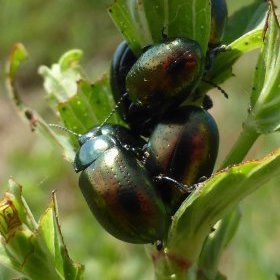|
|
[For the Dutch version, see the ABS Focal Point website.] Welcome to the fourth ABS Focal Point newsletter! The main subject of this newsletter is the revised Guidance on the EU ABS Regulation (Regulation (EU) 511/2014), which was officially published by the European Commission on 12 January 2021. We will take a closer look at the revised Guidance and highlight a number of topics that might be of particular interest to our readers. If there are any specific topics you would like to know more about, let us know by sending an email to NagoyaNL@wur.nl. This newsletter contains:
|
|
Revised EU Guidance: in short
The revised Guidance provides more detailed information and practical examples on the scope and user obligations of the EU ABS Regulation (Regulation (EU) 511/2014). The document was created in close consultation with users of genetic resources from different sectors and ABS experts from the EU Member States.
Annex II in particular provides specific guidance on when activities with genetic resources are considered to be utilisation in the meaning of the EU ABS Regulation, following the logic of the value chain as closely as possible.
|
|
Utilisation in the sense of the EU ABS RegulationIn the sense of the Nagoya Protocol and the EU ABS Regulation, utilisation of genetic resources is: “to conduct research and/or development on the genetic and/or biochemical composition of genetic resources, including through the application of biotechnology.” The Guidance states that both basic and applied research may be considered utilisation. As a type of ‘litmus test’, users should ask themselves whether what they are doing with the genetic resources creates new insight into genetic and/or biochemical characteristics of the genetic resource which is of (potential) benefit to the further process of product development. If this is the case, the activity goes beyond mere description, should be considered research, and therefore falls under the term ‘utilisation’. Not all activities with genetic resources are considered to be utilisation. As requested by users of genetic resources, the Guidance provides further specification of the concept of ‘utilisation’. Particularly relevant in this respect are section 2.3.3 and Annex II of the Guidance. Annex II follows the logic of the value chain as closely as possible, from acquisition, via storing, management of collections, identification and characterisation, to product development, product testing and placing of a product on the market. Many examples (cases) are given, drawn from different sectors and often based on feedback from stakeholders that identified issues and challenges in the interpretation of the Regulation. |
Taxonomic identificationTaxonomic identification of genetic resources, by morphological or molecular analysis, including through use of DNA sequencing, is not considered to constitute utilisation in the meaning of the EU ABS Regulation, as it does not involve the discovery of specific genetic and/or biochemical properties. Taxonomic studies, where they do not look into genetic properties (functionality), are thus not within scope of the EU ABS Regulation. Discovery, description and publication of new species would also not qualify as utilisation in the meaning of the EU ABS Regulation, as long as this is done without additional research on the genetic and/or biochemical composition of the genetic resources to discover or making use of the properties (functions) of the genes. However, if the identification or taxonomic description of an organism is combined with research on its specific genetic and/or biochemical composition, specifically the function of the genes, this would qualify as utilisation in terms of the EU ABS Regulation. For more information and practical examples on taxonomic identification, see section 2.3.3.1 of the Guidance and section 6.1 of the Guidance’s Annex II. |
Testing and reference toolsThe application of genetic resources as testing or reference tools is not considered to constitute utilisation in the meaning of the EU ABS Regulation. At that stage the material is not the object of the research in itself, but only serves to confirm or verify the desired features of other products developed or under development. At an earlier stage, however, research and development may have been carried out on those genetic resources with the aim of turning them into (better) testing or reference tools, and this research and development would be within the scope of the Regulation. Examples of testing and reference tools are laboratory animals used to test their reaction to medical products, pathogens used for testing the resistance of plant varieties, pathogens used for testing biocontrol agents, rats used in toxicological studies aimed at testing synthesised compounds, and bacteria used for testing the effectiveness of compounds that are candidates for new antibiotics against those bacteria. For more information and practical examples on testing and reference tools, see section 2.3.3.2 of the Guidance and sections 7.1 and 7.2 of the Guidance’s Annex II. |
|
Scope of the EU ABS RegulationIn a previous newsletter, we wrote about the scope of the EU ABS Regulation (read: 'EU ABS Regulation: in or out of scope?') and a tool to help you determine if your activities with genetic resources are in scope of the EU ABS Regulation ('Help tool').
The revised Guidance provides more information on the scope of the Regulation. We highlighted two topics below: commercial plant varieties and derivatives.
|
Commercial plant varieties
When a commercial plant variety has been legally placed on the EU market, further use of this variety in plant breeding does not fall within the scope of the EU ABS Regulation, as the subsequent breeder relies on a new and different genetic resource, different from the initial genetic resource. This also applies to new varieties that are protected by a plant variety right according to the UPOV Convention, including under Regulation (EC) 2100/94 on Community Plant Variety Rights.
Consequently, the obligations of the EU ABS Regulation do not apply, and no due diligence declaration is required with regard to breeding activities involving the use of varieties that have been legally commercialised in the EU and/or protected by a plant variety right according to the UPOV Convention inside or outside of the EU.
However, provider countries may have national access legislation for their genetic resources, which may differ from the EU interpretation. This means that even if commercial plant varieties are outside the scope of the EU ABS Regulation, they may be in scope of national access legislation of the provider country. Check the national legislation, or you may run into problems with the authorities of the country concerned. For more information, see section 8.4 of the Guidance’s Annex II. |
DerivativesA ‘derivative’ is defined by the Nagoya Protocol as: “a naturally occurring biochemical compound resulting from the genetic expression or metabolism of biological or genetic resources, even if it does not contain functional units of heredity”. Access to derivatives is in scope of the EU ABS Regulation when there is an ascertainable level of continuity between a derivative and the genetic resource from which it was obtained. This is the case when access to a derivative is combined with access to a genetic resource from which that derivative was or is obtained or when research and development on such derivatives is addressed in mutually agreed terms (MAT) transferred to the user. Continuity is considered to exist in the following situations:
Such continuity is not considered to exist (and research and development is out of scope of the Regulation) when:
For more information, see section 2.3.4 of the Guidance. |
|
|


